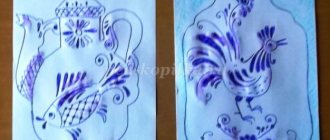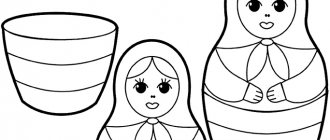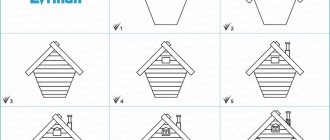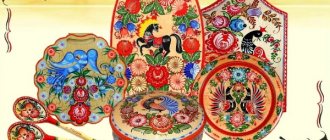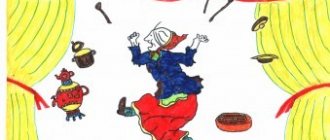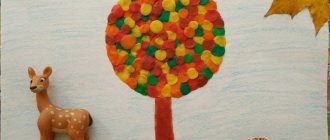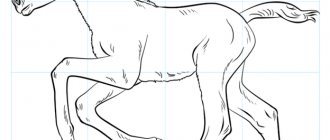• Continue to get acquainted with Gorodets painting, its color, and features.
• Be able to identify the main elements of a pattern.
Tasks:
• Educational: practice drawing Gorodets flowers - baths, roses, observing the sequence of stages of the image; in applying the resin using the tip of a brush.
• Developmental: Develop a sense of composition, the ability to beautifully arrange a pattern in a given shape. • Educational: develop artistic taste and cultivate love and interest in folk art.
Fragments of notes from an open lesson on painting in the senior group - table
| Author and topic title | Name of the lesson part | Progress |
| Lapekhina Tatyana, “Gorodets painting” | Organizing time | <...Guys, look at these painted wooden products. Who knows what this painting is called? …><…Guys, do you know why it’s called that? |
| Main part. Presentation of a new topic | Educator: On the banks of the Volga lies the ancient city of Gorodets - the oldest Russian fortress city. Here, a long time ago, people began to make dishes from wood and paint them with various patterns. These could be scenes of feasting, festivities, trips and hunting trips were depicted. They also painted garlands of flowers or a large flower with leaves radiating from it. There were other options, with motifs of birds and cats. Battle scenes were depicted - they were whole pictures. Someone carved spoons, cups, bowls, salt licks, and the suppliers sharpened them on a lathe. Someone made tools for spinning and weaving. There was a spinning wheel trade. At the same time there was a factory. Factory for the production of children's furniture and other household items: children's chairs, tables, rocking horse, boxes, cups, cutting boards, dishes, bread bins. Currently, the natural yellowish color of wood is used as a background. Guys, tell me what colors are in Are the paintings used by Gorodets masters? The colors in the pattern are few, but in very bright combinations - red, blue, green, rich orange and its shades. White and black colors in painting have a special meaning. These 2 colors have the ability to influence the sonority of the colors and contribute to their favorable combination. Guys, what elements do the masters use in painting? Answers from the children (clarification of names: rose, kupavka, berry, leaves, horse, birds). This is a rose, this is a kupavka, this is a chamomile. Look carefully at these flowers, they can be in blue and blue tones, or pink-red. Chamomile is easy to recognize. It has many thin petals. The center of the kupavka is shifted. Guys, would you like to try yourself as a craftsman and learn how to perform elements of flower painting? Okay, let's get to our jobs. | |
| Practical work | On the board you see a sample of writing a flower called a daisy, its step-by-step implementation. Stage 1 is called “underpainting” (an image of a blue circle in the center of the sheet, stage 2 is called “shading” (a circle in the center and chamomile petals with blue paint) and stage 3 is called “revival” (swirls and dots are made with white and black paint). You have on the table there are sheets pre-painted yellow (you can offer children a choice of different shapes of dishes: vases, cutting boards, etc.). Let's proceed to the first stage of execution. Take the blue color and draw an underpainting - a circle in the center of our work While our circle is drying, we will draw more green leaves, creating a composition. Now we move on to the second stage of execution. We use blue to shade: draw a blue circle in the center of the flower, and now we place the petals opposite each other in a circle. Who can tell me how to do this? (by dipping the brush). Before starting the third stage, you will need to wait a little for the paint to dry. We do physical exercises or gymnastics for the eyes. The final stage is “revival.” We will apply white and black paint in the form of dots, droplets, curls with a thin brush. | |
| Bottom line | Children lay out their work on one table, choose the ones they like best, share their impressions and express their wishes about what element they would like to learn to perform in the next lessons. Poems learned in advance are read. Exhibition of children's works...> | |
| Quote By: | https://www.maam.ru/detskijsad/konspekt-otkrytogo-zanjatija-v-starshei-grupe-po-teme-gorodeckaja-rospis.html |
Summary of a drawing lesson in the preparatory group “world of wild animals”
Master class on drawing for children from 7 years old. Gorodets painting
How to draw a Gorodets pattern on a plate step by step for children from 7 years old
Author: Oksana Nikolaevna Bogatova, teacher of MKDOU “Kindergarten No. 94” Dzerzhinsk, Nizhny Novgorod region. Description: the master class will be of interest to educators, primary school teachers, additional education teachers, and parents. Children 6-7 years old will be able to complete the work with the help of adults, and older children - independently. Purpose: the panel plate can serve as a gift to relatives, friends and also decorate the interior of the kitchen. Goal: creating a decorative panel with Gorodets painting. Objectives: - continue to introduce children to folk crafts; — learn to make a pattern from elements of Gorodets painting; — improve your drawing skills with a thin brush; - develop a sense of composition; - cultivate interest and respect for folk art. Before starting the master class, I suggest taking a moment to remember the history of Gorodets painting and feel its sunny, kind atmosphere.
Gorodets wood painting is a famous folk craft of the Nizhny Novgorod region. It developed in the second half of the 19th century in the Trans-Volga villages near the city of Gorodets. Residents of the surrounding villages were known as skilled artisans, among whom were blacksmiths, weavers, dyers, carvers, carpenters and joiners. There was a lot of forest in the Volga region, and it provided a lot of cheap material from which everything was made: from children's toys to furniture.
Gorodets spinning wheels were especially famous, which were sold in large quantities at the Nizhny Novgorod fair and distributed throughout Russia. People bought them with pleasure thanks to the funny painted pictures on the bottom of the spinning wheel. After finishing work, housewives decorated the walls with such donuts instead of paintings. Soon, such painting began to decorate not only spinning wheels, but also many household items: chairs, baskets, boxes, salt shakers and toys. Gorodets painting is unique in its style, so it is quite difficult to confuse it. Not a single Gorodets product is complete without lush garlands and bouquets of flowers reminiscent of roses and daisies.
The subjects of Gorodets products had a kind of unique plot. Masters depicted gentlemen walking with ladies, riders on horses, tea drinking scenes in rich interiors.
Previously, Gorodets painting was done with egg paints, which were applied to the product in large spots of color, without a preliminary outline. The drawing was applied in free strokes with a graphic outline in black or white. The predominant colors were blue, red, white and black. Nowadays, craftsmen use oil paint, which has expanded the color range. But the motives and technology of Gorodets painting remained the same. Modern artists, as before, paint all kinds of wooden products: boxes, caskets, decorative panels, cabinets, shelves, bread bins, salt shakers, toys and furniture.
It has become a tradition for Nizhny Novgorod schoolchildren to visit Gorodets on excursions.
There they will learn a lot of interesting things from the history of the Nizhny Novgorod region. They plunge into the atmosphere of the life of their ancestors. They can touch everything with their own hands.
And, of course, they participate in master classes by local artists. Children are delighted with such trips.
Now let me introduce my master class on drawing Gorodets painting. Materials: paper plate, white acrylic primer, primer brush, painting brushes No. 1, No. 2, No. 5, gouache (yellow, ruby, white), watercolor paints, simple pencil.
Cover the plate with primer (acrylic dries quickly).
Let's depict one of the elements in the center of the plate - a chamomile. In Gorodets painting, a chamomile can be blue, purple, red, or orange (a multi-petaled fantastic flower). We apply the drawing with a simple pencil.
Stage “underpainting”. We make the background with yellow gouache (brush No. 5).
Mix ruby and white gouache to get a pink color. Making a pink background.
We outline the flower with red watercolor and paint the circle in the center (brush No. 2).
Inside the red petals we make a second row, then with white watercolor we outline the petals around class=”aligncenter” width=”627″ height=”470″[/img] We outline with white the large petals inside and the small ones outside (brush No. 2), add three strokes (white and red) apply dots (brush No. 1).
Now, draw the leaves with mustard color. The leaves in Gorodets painting vary in size, but are always arranged in groups. At the same time, they never exceed the size of the central flower of the composition.
Draw green leaves.
We make veins on the leaves (brush No. 1) - we draw a line along the leaf and several short ones across it.
Veins on green leaves are done differently.
The “revival” stage. We emphasize mustard-colored leaves on all sides with a thin line (brush No. 1) with black paint, and green leaves on one side with tendrils.
Our plate is ready.
In the center of the plate you can depict other options for Gorodets flowers, for example, roses.
An addition is a loop for hanging the panel on the wall.
My work for the holiday of Easter.
Thank you for your attention!
We recommend watching:
Gorodets painting on a cutting board Gorodets painting on a cutting board. Master class with step-by-step photos Gorodets painting of a cutting board. Master class with step-by-step photos Do-it-yourself panels made of colored paper. Master class with photos “Gorodets patterns”
Similar articles:
Gorodets painting. Master Class
Subject painting
This can be a painting in two or three tiers, traditional for the craft. In this case, the main plot is written in the upper part (feast or festivities, for example), while in the lower part there are plots that allow the theme to be revealed. The middle part is usually represented by a floral stripe. If the boards do not have a completely elongated shape, the artist can do without the lower tier: he depicts only the main plot scene, which is surrounded by a floral stripe.
The horseman symbolizes the groom in Gorodets painting
A male figure on a horse is the groom, a modest girl near a birch tree is the bride, with this reading everything is simple
Please note that in scenes of feasts the table is always carefully drawn, and in principle it is not empty, there is a samovar on it, a vase of flowers as a symbol of prosperity
The faces of the heroes of the plot compositions (and this is striking) are turned to the viewer; people turned to three quarters are extremely rare. We can say that the owner of the box or board sees himself (a loved one) in the plot in the circumstances he desires.
You can view all of the above types of Gorodets painting compositions using the example of finished works in the video presented.
Photo gallery: examples of children's work
Pupils of the senior group quite adequately depicted the Gorodets bird Pupils of the senior group quite adequately depicted the Gorodets bird Focusing on the step-by-step drawing scheme, the guys can quite well depict a bird The original basis for work is a template of a wooden spoon The original basis for work is a template of a wooden spoon To begin with, the guys can practice creating a pattern on rectangular base, and then on a dish template Each board has a border of a certain color, which makes it more beautiful Each board has a border of a certain color, which makes it more beautiful The flower arrangements turned out bright and juicy Blue flowers in the Gorodets style look very elegant Blue flowers in Gorodets style look very elegant. The semicircular floral pattern on the plate looks wonderful
Gorodets painting will give preschoolers a lot of positive emotions, because fairly simple elements allow you to create incredibly beautiful compositions. The teacher only needs to think through interesting topics for classes, choosing a suitable basis, and be able to interest children as much as possible in this type of Russian folk craft.
Video materials
A short slideshow accompanied by folk music with photographs of products from Gorodets craftsmen
Suitable for display on a projector.
https://youtube.com/watch?v=PvMa-4MUTEM
Master class “Drawing a berry”
Master class “Drawing underpainting”
Master class “Shadow and revival”
Open lesson on visual arts “Gorodets painting”
Decorative drawing classes expand children's knowledge about folk crafts, music, and folklore. The pupils' vocabulary is actively expanding. Palekh, Khokhloma, Gzhel, Gorodets - these words will be filled with meaning for the children and will be preserved in their memory with bright, fabulous images. Studying the features and techniques of Gorodets painting contributes to the development of spatial and figurative thinking, the ability to independently plan actions and construct a composition. By creating drawings based on Gorodets painting, the children themselves can choose the shape of the workpiece, think over the type of future ornament and choose colors for work. The works of masters from Gorodets are close to children with their colorfulness and simplicity of composition, encouraging independent creativity.
Basic techniques
There are three stages of the technique of drawing pictures in Gorodets painting. Prepare a base of wood and cover it with yellow, less often red or black. On it, with a pencil, the master outlines the location of the main elements and their size. Experienced artists paint with paints without a sketch.
Next, with one movement of a wide brush, draw a circle, highlighting the main parts of the composition, for example the base of a flower. This stage is called “underpainting”. To draw a pattern, use pink, blue, or dark blue paints. They also use yellow, red, burgundy, and black.
The name of the second stage of Gorodets painting – “shade” – speaks for itself. A brush with paint of a darker color carefully draws important details:
- clothing lines;
- petal brackets;
- veins on the leaf.
At the final stage of Gorodets painting, strokes, arcs, and drops are applied with the tip of a thin brush. With their help, the work acquires elegance, the pattern becomes animated. Hence the name of the stage – “revival”. They paint with white and black paints.
To protect the painting from damage, the dried painting is coated with colorless varnish in several layers.
There is also a technique for drawing patterns when the artist wants to depict only flowers. The following elements are used:
- rosean (the largest round flower);
- bud (small rose);
- rose (added bud);
- kupavka (the center of the flower is to the right or left of the center);
- chamomile (many petaled flower with unpredictable color).
To make a rose, you first need to draw a circle with red or pink paint. It is depicted with a wide brush with one or two strokes. Then they begin to “shade” - with a thin brush, using darker paint, highlight the center and the petal-brackets around the entire circle. At the end, they make a “live-up” with white - they apply a lot of dots, droplets, and strokes.
Kupavka is similar in Gorodets painting technique to rosan. The pattern begins with underpainting - a circle is drawn, then its “shadow” begins. Only in this case the center is shifted to the side, the top of the bud is made in the shape of a ball. Next, semicircular petals are drawn from the center to the edges - the closer to the bud, the smaller the petals become. The “revival” is done with white paint; all elements of the interior of the pattern must be drawn.
To depict a rose, draw a bright circle. Petals in the form of semicircles or leaves are added to it, also decreasing towards the bud. In this case, it is not necessary to do “shading”; you can immediately move on to “giving life” using white or black paint. The center is decorated with small brackets and dots. Petals can be “revitalized” with drop strokes.
The easiest way to draw a chamomile. Using a medium-sized brush, make a circle and mark its center. Drop-shaped strokes are drawn from it to the edges. Next comes the “revitalization” of the petals with white paint.
In addition to flowers, Gorodets works always contain a lot of leaves, different in size and shape. They are located in groups of several. The shape of the simplest leaf resembles a pumpkin seed.
Gorodets painting is one of the brightest artistic crafts. Despite the fact that at the beginning of the 20th century it almost ceased to exist, talented craftsmen and artists were able to preserve the traditions of the Gorodets style. In many countries around the world, visitors to museums and exhibitions can see animals, birds, flowers, as well as entire scenes depicting the life of peasants on painted objects. Now this art is national pride.
We also recommend watching a video on our topic.
Art of Gorodets. Origins and modern development of the fishery.
- https://ru.wikipedia.org/wiki/Gorodets_painting
- https://womanadvice.ru/gorodeckaya-rospis-chto-eto-takoe-istoriya-osnovnye-elementy-i-cveta-kakie-est-vidy
- https://www.gpa.cfuv.ru/attachments/article/3566/Painting%20on%20wood%20Seagull%20N.M..pdf
Schemes for working on Gorodets patterns
In drawing classes, simple plots are used to master the elements of painting. But each job must be done in a certain order.
"Bud"
Work on this variety of flowers is carried out in accordance with the instructions.
The color of the buds can be varied, but only within the color scheme of Gorodets painting
- We start with the underpainting. We take red paint with a wet brush, remove the excess and dip it in water again so that the color is washed out.
- Draw a circle - apply pressure with the brush, then draw a semicircle and lower the brush down.
- Next, we do the shading - we take concentrated red and draw half-arcs on the buds, draw dots. Don't forget to hold the brush strictly vertically.
- We use green paint to spice things up - green leaves.
This work can be spiced up, that is, elements can be added.
"Chamomile and Kupavka"
Instructions:
- First we work with daisies.
- We do the underpainting with pink paint (we blur the red paint).
- Using rich red we create a shade - strokes located along the diameter of the daisy. Don't forget to hold the brush perpendicularly downwards.
- Let's start reviving. Making the red core of the flower.
- To brighten it up, use white paint to dilute the shade - alternate black strokes with white ones, and also make dots in the middle.
- We create the underpainting of the kupavka - draw a circle.
- Shading is a drawing of the middle.
- Let's make a preparation - draw white veins-petals in the form of two semi-arcs with jumpers.
"Rozan"
Now we will describe the instructions for working on the “rosan” variety:
- For the underpainting we make a red circle and two leaves on the left and right.
- Using white paint we draw semi-arcs in the upper third of the rose.
- We connect them with strokes.
- We make petals emanating from the lower semi-arc.
- We make vertical strokes in each petal.
- We draw vein lines on the leaves.
Lesson note plan
The work takes place within a standard 30-minute lesson. And during this time, children should not only get acquainted with theoretical aspects (the history of the tradition), but also try themselves in practice as Gorodets masters. Before allocating the time that will be spent on each stage of the lesson, it is necessary to formulate goals and objectives. The goal-setting aspects are:
- acquaintance with the history of painting;
- learning to write individual elements of the Gorodets technique (for example, rosean, leaf, kupavka, etc.);
- strengthening the skill of working with paints and brushes.
Tasks include:
- continued work on developing the ability to build a composition of a drawing;
- training in working with technical elements (dots, animations, dashes, etc.);
- education of aesthetic perception of folk art.
An approximate timing would be:
- introductory part - 7 minutes (story about the history of painting with viewing of presentations, conversations about what was seen or heard, if we are talking about looking at pictures);
- main part - 18 minutes (work on drawings according to the teacher’s instructions with breaks for finger exercises, physical education);
- final stage - 5 minutes (drawing up a spontaneous exhibition of children’s works, choosing the most similar one, brief self-analysis: “What happened?”, “What caused difficulties?”, praise from the teacher).
The teacher must control each stage of the drawing, showing how to apply pressure with a brush correctly
